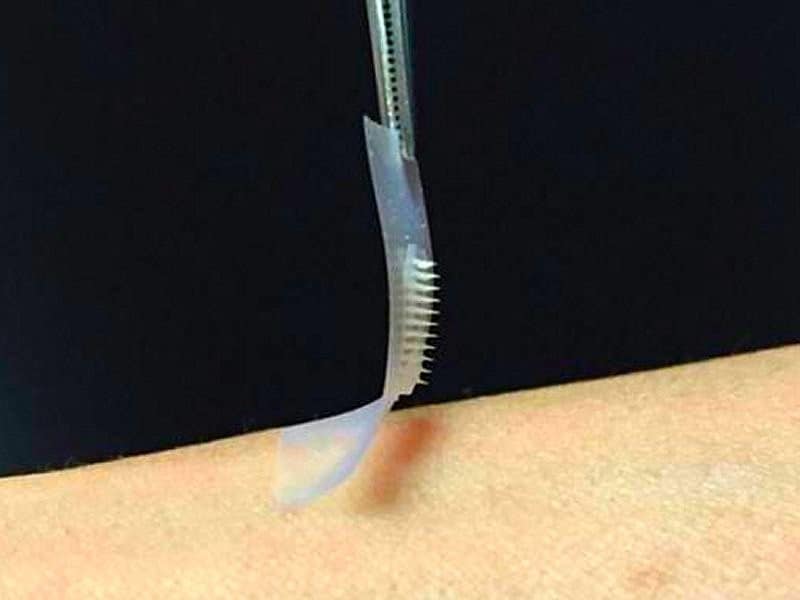
One of the biggest complaints of those diagnosed with diabetes or fear of those who have heard their doctor’s mention ‘insulin’ is the pain associated with the injections. For millions of people worldwide with diabetes, these painful injections may be a thing of the past soon. This is all possible thanks to an innovative invention from the researches at the University of NC State and North Carolina. What have they created to make these injections go away?
Contents
An Invention that May Save Lives

There are many type 2 patients who refuse an insulin treatment regime simply because they do not want to give themselves insulin injections. Whether they are afraid of needles or simply do not want to deal with the pain that comes along with them, this new invention could literally save their lives.
They have designed a smart insulin patch that will detect any increase in blood sugar and then secretes a dose of insulin into their bloodstream when it is needed. This amazing device is no bigger than that of a penny and on it has hundreds of teeny tiny needles that are only the size of an eyelash. These needles are known as microneedles.
I recommend reading the following articles:
These microneedles really make the world of a difference. They have microscopic storage for units of insulin and the glucose sensing enzymes which will release when blood sugar levels get to be too high. The study conducted had found that this painless little patch was able to lower the blood sugar levels in the mice subjects who had type 1 diabetes for up to nine hours. There is more clinical testing needed and then clinical trials for humans will be required before the patch can be used on patients, but it’s definitely something that is showing wonderful promise for those with diabetes.
Removing Human Error
Diabetes affects millions of people around the world upwards of 387 million and is expected to keep growing each and every year. Those with type 1 and advanced type 2 diabetes try their best to keep their levels under control by checking their blood sugar frequently and using multiple insulin shots. This process is painful one to say the least, but it’s also imprecise.
Injecting the incorrect amount of insulin can lead to severe complications such as lose of eye sight or even as serious as death.
In the past closed loop systems have been utilized by researchers to try to reduce human error. The only issue with these approaches is that they use sensors and pumps which need to be replaced every few days.
The Science Behind the Study
In this study, instead of trying to create another device, they tried to emulate the body’s natural ability for insulin generation known as beta cells. These cells act as warehouses and even factories that work to store and make insulin in small sacs which are called vesicles. They also work like an alarm to detect and sense when blood sugar levels are getting too high and signal the release of more insulin into the body.
What researchers have done with this smart insulin patch and the microneedles is reconstructed artificial vesicles to function the same. The result of this study came millions of small bubble like structures which were much smaller than a piece of human hair. Into each of these artificial vesicles they placed a core of insulin and the enzymes which were created to detect high blood sugar levels.
In the lab experiments on the mice, when their blood sugar levels increased the extra glucose began to crowd the artificial vesicles. The enzymes used to detect high levels then converted this glucose into gluconic acid while consuming oxygen during the process. The lack of oxygen caused a hypoxia state which made the molecules turn hydrophilic. This caused the vesicles to fall rapidly apart and then send insulin into the bloodstream.
Mice with Type 1 Diabetes and Their Role
The researchers then began testing their creation in mice with type 1 diabetes. One set of the mice were given an injection of insulin, then their blood sugar levels were monitored. It was found that they dropped back to a normal level, but they also began to quickly climb back into hyperglycemia.
When the mice with type 1 were treated with the smart insulin patch the blood sugar levels were lowered into a controlled level. Within thirty minutes they were still within control and remained that way for many hours later.
Researchers also discovered that they were able to tune the smart patch to help alter blood sugar levels into a certain range by just varying the amount of enzyme they put into each of their microneedles. They also noted that the patch did not pose any potential dangers like injections do. With too much insulin this can send the blood sugar dropping to a dangerous level. Mice are much less sensitive to insulin than humans are. Because of this, the researchers believe that the stabilizing effect of the patch on blood sugar levels may last much longer when given to humans. The goal in all of this research is to create a smart insulin patch that would only have to be changed every few days.
Further reading:
Wrap-Up
The difficult part of diabetes management and care isn’t just insulin shots, or the frequent blood sugar checks, or even the strict diets you must adhere to, but the fact that people with diabetes have to do all of these many times a day for the rest of their lives. If researchers are able to get these smart insulin patches to work for people with diabetes, this could definitely be a huge game changer and a step in the right direction. While it’s not entirely a cure, it’s moving forward in a more positive manner. Let's hope painful injection are not something we have to experience for any longer.
TheDiabetesCouncil Article | Reviewed by Dr. Christine Traxler MD on May 29, 2020






